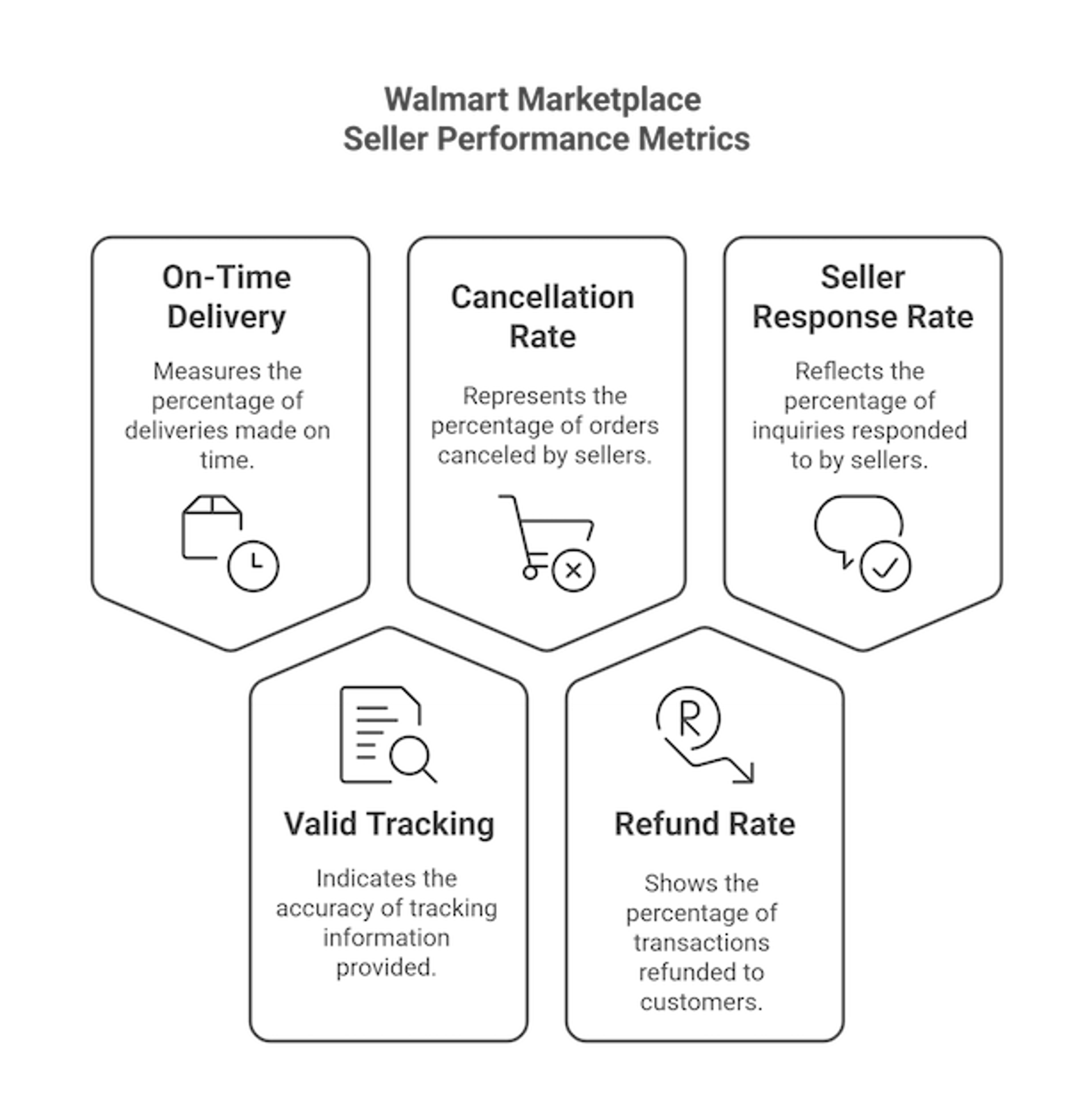/Understanding the Walmart Seller Performance Dashboard & Key Metrics

Understanding the Walmart Seller Performance Dashboard & Key Metrics
For sellers on Walmart’s Marketplace, understanding the Walmart Seller Center’s Performance Dashboard is crucial for success. This dashboard provides essential insights into your store’s performance, customer satisfaction, and operational efficiency. By leveraging these metrics, sellers can optimize their business strategies, expand their product offerings, and enhance customer service. In this comprehensive guide, we will explore the Walmart Seller Center Performance Dashboard, break down key performance indicators, and discuss actionable steps to improve your seller rating and sales performance.
What is the Walmart Seller Performance Dashboard?
The Performance Dashboard in Walmart Seller Center is an analytics tool designed to help sellers monitor and optimize their marketplace performance. It provides data on various operational and customer-centric metrics, enabling sellers to make informed business decisions. It’s important to note that it is the seller's responsibility to review their account performance regularly and proactively improve performance metrics that don’t meet Walmart Marketplace standards.
Seller Performance Metrics Explained
There are five key metrics that comprise Walmart's Seller Performance Standards. These metrics help ensure high-quality, consistent customer experiences on Walmart Marketplace. They are so critical that Walmart requires marketplace sellers to meet minimum qualifications for each of the five metrics:
1. On-Time Delivery Rate (OTD):
This is the percentage of orders delivered on or before the expected delivery date. Sellers must maintain an OTD rate better than 95%.
2. Valid Tracking Rate (VTR):
This is the percentage of orders with valid tracking information provided. Sellers must maintain a VTR over 99%.
3. Cancellation Rate:
This metric is the percentage of orders that a seller cancels after receiving the order from Walmart. Sellers must maintain a cancellation rate of less than 2%.
4. Refund Rate:
This rate is the percentage of refunded orders for reasons the seller is responsible for, such as damaged or incorrect items. A seller's refund rate must be below 6%.
5. Seller Response Rate (SRR):
This is the percentage of customer inquiries responded to within 48 hours. Sellers must maintain a SRR rate of over 95%.
By staying on top of these metrics, sellers can identify areas of improvement and take proactive steps to enhance their performance.

How Performance Metrics are Calculated
Performance standards are evaluated based on the last 30 days of your performance. Walmart categorizes performance issues by two factors and only calculates performance scores using "Seller accountable" metrics.
- Seller accountable: These are performance factors that may affect the customer’s experience and the seller can control. Examples include a late hand-over to carrier, no carrier scan and ship location mismatch.
- Not accountable: This classification is used when performance factors that may affect the customer’s experience are not in the seller’s control. For instance, delays with the shipping carrier. Walmart also proactively monitors severe weather, natural disasters, and fraudulent data issues which may result in metrics being classified as 'non accountable' also.
Consistently monitoring the metrics that are within your control is crucial to performance on the marketplace. Thankfully, Walmart's Performance dashboard makes it easy!
Using the Seller Center Performance Dashboard
The Performance dashboard in Seller Center is where you can find a complete view of your Seller Performance metrics along with a detailed overview of your order and fulfillment performance. To access the Performance dashboard in Seller Center, navigate to the Performance tab.
On the dashboard, you will see a detailed summary of the top factors contributing to your overall performance score. You can view metrics for specified time frames and download reports.
When order and fulfillment issues arise, the Performance overview summarizes total Gross Merchandise Value (GMV) loss, the number of impacted customers and orders, as well as the severity of the performance issue. If your metrics drop below the standard, Walmart will offer tips to improve your metrics.
To help sellers adhere to Seller Performance Standards, the Performance dashboard includes Ship location mismatch information under On-time delivery. You’ll gain insights into expected vs. actual shipping zip codes, helping you identify and address inconsistencies in your shipping operations.
Recently, Walmart added an Incentives section under the Performance tab as well. This gives sellers the ability to track quantities sold, savings earned, and GMV generated from enrolled subsidies.
Additional Walmart Seller Insights
Pricing Insights
The Pricing Insights dashboard allows you to manage the prices in your catalog. It displays account-level pricing performance metrics and SKU-level pricing information to help you identify opportunities.
The dashboard provides two metrics to track your price performance:
- Price competitiveness: This measures your catalog’s price parity against the competition. If your products receive high page views, they’ll have a larger impact compared to products with lower page views. Products with no page views in the given time frame will not have any impact on the score.
- Buy Box win rate: This measures the overall percentage of page views where your offers are winning the Buy Box. For example, a 75% Buy Box win rate would indicate that you’re the Buy Box winner for 75% of all page views that your items are receiving.
You can manually update your prices in the dashboard, and you can download a report to view the pricing performance of your catalog. However, many successful sellers choose to use more advanced repricing software which removes the hassle of micromanaging prices, and allows you to focus on other aspects of your Walmart business. Aura's automated Walmart repricer, powered by AI, adapts to market changes fast while following your minimum and maximum prices.
Ratings & Reviews Manager
The Ratings and Reviews Manager is another helpful dashboard for sellers as it provides a centralized hub for monitoring and managing customer reviews. Keeping a close eye on these metrics is vital to the success of your business. Customer feedback, including product reviews and ratings, plays a significant role in a seller’s reputation. Higher ratings increase conversion rates and trust, while negative reviews can deter potential buyers.
Walmart considers customer satisfaction a priority, so negative feedback can impact visibility and sales. The Ratings & Reviews dashboard allows you to correlate reviews with specific orders and pinpoint the products that received the negative (or positive) feedback. This makes it easier for sellers to resolve issues related to fulfillment, listing quality, and customer service.
Returns Insights
The Returns Insights dashboard provides historical data and detailed information and about your returns, including the return reason and amount refunded. The dashboard highlights SKU-level details on all of your returned items, and allows you to view the reason for a return or identify defective items. You can also search for returned items by name or filter by the total number of returns, return reason or fulfillment method. The returns data is aggregated weekly and updated on Saturday.
Additional metrics included in the Returns Insights dashboard are:
- Total returns
- Refund rate
- Refund gross merchandise value (GMV)
- Returns processing fees
- Units returned within a date range
To access the Return Insights dashboard, select Returns under Orders in Seller Center, then choose the View returns insights button.
Listing Quality Dashboard
The Listing Quality dashboard, found under Growth section in Seller Center, is a helpful tool for optimizing listings. The Listing Quality snapshot displays a comprehensive overview of your Listing Quality Score and the five components that go into the measurement: Content quality, Price competitiveness, Shipping speed, Published and in stock, and Ratings and reviews. You can view the score breakdown by category and offer, and see if you rank poor, good, or excellent.
The dashboard also identifies listing issues and missing keywords, and shows suggestions on how to improve listing content and discoverability. You can even filter by Customer Favorites to see trending items that are popular and in demand.
Your Listing Quality score can change over time, so it's important to review these metrics regularly.
How to Leverage the Performance Dashboard for Growth
Understanding Walmart’s Performance Dashboard is only half the battle; leveraging it effectively is key to growing your business. Here are some actionable tips for peak performance:
1. Monitor Metrics Regularly
Frequent monitoring of your performance metrics helps identify trends and areas needing improvement. Set up notifications so you can stay on top of timely event changes like inventory updates, new order updates, and pricing issues. Getting alerts will ensure you can respond quickly to potential issues.
2. Optimize Product Listings for Better Visibility
Walmart's search algorithm prioritizes listings that provide comprehensive and accurate product details. Use SEO-friendly product titles, descriptions, and high-quality images to enhance your listings. By optimizing product listings with SEO best practices, businesses can improve discoverability and ultimately attract more customers to your brand.
3. Enhance Customer Support
Providing excellent customer service leads to positive reviews and repeat customers. Respond promptly to inquiries, resolve disputes efficiently, and offer hassle-free returns when necessary.
4. Implement an Intelligent Pricing Strategy
Walmart uses an algorithm to compare your prices with competitors across various platforms. Therefor, competitive pricing is essential for securing the Buy Box and increasing sales. Use a modern repricing tool to stay competitive without compromising profitability. Consider bundling products, offering discounts, and participating in Walmart’s promotional campaigns.
5. Improve Shipping Logistics and Fulfillment
Optimal order fulfillment minimizes late shipments and cancellations. Key aspects to review in your inventory process include order accuracy, warehouse efficiency and shipping speed. Poor shipping performance can result in customer dissatisfaction and lower sales. Use reliable shipping carriers, automate order processing to minimize delays, and provide accurate tracking information. Consider using Walmart Fulfillment Services (WFS) to take advantage of Walmart’s logistics network.
6. Engage with Customer Reviews
Actively responding to customer reviews demonstrates commitment to quality and service. Address concerns professionally and take feedback into account for future improvements with your products, packaging, and listings.
Submitting Appeals and Troubleshooting Performance Issues
As a Walmart seller, you may encounter performance issues or concerns that require attention. Walmart provides a structured approach to resolving these issues through the Seller Center, ensuring that you can maintain smooth operations and high seller performance.
What if I Don't Meet the Seller Performance Standards?
If your account does not meet one or more of the five metrics included in the Seller Performance Standards, you will receive a performance alarm via email from Walmart with a recommendation on how to resolve the issue. You must take immediate action to address or improve your performance, or your account may be at risk of suppression, suspension or termination.
Suppression, Suspension and Termination Defined
- Suppression: Your seller-fulfilled listings are removed and any Walmart-fulfilled listings will remain.
- Suspension: Your seller-fulfilled and Walmart-fulfilled listings are removed.
- Termination: Your Walmart selling privileges and access to Seller Center are permanently revoked.
How to Appeal a Suspension or Suppression on Walmart
If your account is suspended or suppressed, then you need to demonstrate a commitment to improving your performance. You can request to reinstate your selling privileges by submitting an appeal with a business plan of action. (Appeals are not accepted for terminations.) To fully understand what is necessary to include in a business plan of action, refer to the Appeal an Account Suspension or Suppression page on Marketplace Learn.
Resources to Resolve Common Issues
As a Walmart seller, you have access to a variety of resources and support to help you succeed on the platform. Leveraging these tools can significantly enhance your ability to manage your seller account, optimize your product listings, and resolve any issues that may arise.
- Walmart Seller Center: This is the central hub for managing your Walmart seller account. Here, you can access your business details, order management, and product listings. The Seller Center is designed to streamline your operations, making it easier to keep track of your sales and performance metrics.
- Walmart Marketplace Learn: This knowledgebase provides a wealth of educational content, including guides, policies, FAQs, and tutorials to help you get started, optimize your sales, and troubleshoot problems.
- Seller Academy: This learning platform offers in-depth training and resources to help you improve your selling skills and learn best practices for selling on Walmart.
- Sell Better Blog: Stay informed about the latest Walmart Marketplace news, new tools, and enhancements with this blog. You’ll also find tips, seasonal planning guidance, and best practices to help you sell more effectively. Regularly reading the blog can keep your company ahead of the curve and ready to adapt to changes in the marketplace.
- Walmart Marketplace YouTube Channel: This channel offers videos on selling tips, how-tos, and program overviews to help you succeed on Walmart Marketplace. Visual learners will find this resource particularly useful for understanding complex processes and strategies.
By understanding and utilizing these resources, you can effectively manage and resolve any issues that arise, stay informed about marketplace updates, and continuously improve your performance on Walmart.
Conclusion
The Walmart Seller Center’s Performance Dashboard is an invaluable tool for sellers aiming for long-term success on the platform. By focusing on key metrics such as shipping performance, customer reviews, pricing competitiveness, fulfillment, and return rates, sellers can enhance their overall marketplace performance. Regularly monitoring and optimizing these areas will help maintain a strong seller rating, increase sales, and build a loyal customer base. By leveraging the insights from the Performance Dashboard, sellers can navigate Walmart’s marketplace with confidence and achieve sustainable growth.


